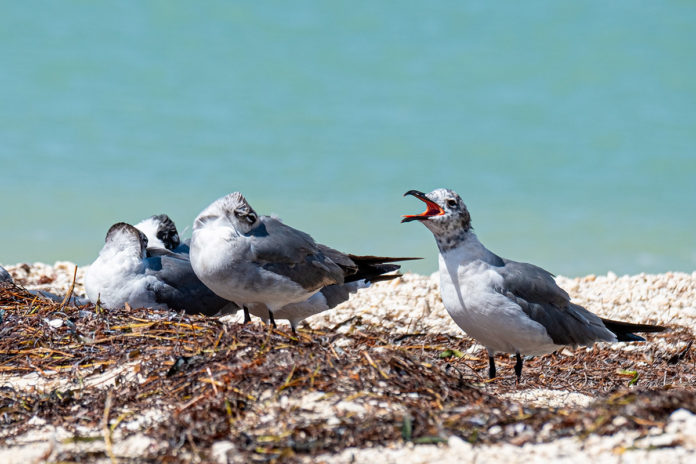A thought occurred to me this week, an unexpected one that, for reasons unclear, has kind of stuck with me: We have some awfully well-behaved gulls here in the Florida Keys.
I saw a tweet during the recent heat wave in England that made me think. It was about a hospital that didn’t have air conditioning, so they were keeping the doors open, and as a result the hallways had filled with seagulls.
It being the internet, some birder got in there and said you shouldn’t really use the word “seagull,” since a lot of those birds can be seen very far inland, away from the sea – trust me, this is a thing in the birder world – and that they should just be called gulls. And then a lot of people got on his case, saying things to the effect that he was just being a pedantic wanker, and if the word seagull was good enough for William Freaking Shakespeare, it was good enough for them, and also, the real point of the whole initial tweet was that as soon as they opened up the doors, gulls decided to take over a hospital.
Why would gulls invade a hospital? Most likely looking for food. According to multiple news reports there is currently a herring gull in England that has figured out how to work the automatic doors at the local grocery store and through repeated sorties has absconded with an estimated £300 worth of crisps (or, if you want that translated into ‘merican, about $400 worth of potato chips). There are, in fact, a good number of videos of gulls sneaking into stores over there and making off with bags of potato chips – usually the single serving size – but also the occasional tuna sandwich or bag of Doritos. Indoors, to some gulls, apparently equates to food.
British coastal towns seem to be a hotbed of gull-on-human robberies. Ten seconds of Googling can lead to you to a solid number of compilation videos of gulls stealing food from people at the seaside – fish, fries, Cornish pasties, burgers, prawn sandwiches, ice cream cones. Some of these are labeled as attacks, but the birds aren’t aiming to do harm to the people; they just want their food.
I have also seen at least four different videos of gulls stealing GoPros and flying off with them. These are always entertaining to watch, and you have to wonder how many GoPros get stolen and not recovered.
Gull-on-human robberies are apparently so common in the UK that the University of Exeter put out a video with advice on the best way to avoid having a gull steal your food. The short answer: glare at them. Unwavering eye contact seems to keep them at bay. Which makes sense. In most of the videos out there, the gulls seem most successful when approaching quickly and from people’s blind sides. Of course, this is not just a problem in the UK. My editor, Mandy – a woman who, because of some traumatic experience with a peacock that, years later, she still can’t coherently speak about, is not a fan of birds, but still bravely lets me write this column every week – recently forwarded me a New York Times story about the gull situation in the Shore town where she grew up, Ocean City, New Jersey.
In it the mayor of Ocean City describes a galvanizing incident when he was at the boardwalk and saw a gull swoop in and steal a slice of pizza from a little girl in a stroller. “The mayor swears he saw blood on the little girl’s face, though he admits it may have been sauce,” the story said.
The central focus of the piece is on the solution that Ocean City took up to try and abate the gull problem: raptors. Specifically, trained raptors, a.k.a. falconry birds. And they have apparently met with some success, keeping gulls at the margins of the busiest areas, but also providing entertainment to beachgoers who were interested in seeing the hawks and falcons work.
The thing to keep in mind in all of these incidents, joking aside, is that the gulls are not really doing anything wrong; they are just doing what works. Since a lot of the habitat that gulls use for feeding – estuaries and marshes and beaches – has been developed, they are basically finding other ways to feed. It is an adaptation. The problem is that they have adapted so well.
So why doesn’t this happen in the Keys? While we have beaches, we don’t have beaches that are quite as commercialized as they are in places like New Jersey and Britain. Other than the spring breaks of yore, the Keys don’t attract beachfront hordes on the same scale. And, a lot of times, what keeps the gulls attracted is a high volume of easily-accessible garbage.
Also, I think it’s our makeup of gull species. We actually have a lot of the same species that create problems in those other places – herring gulls, ring-billed gulls, and lesser black- backed gulls. But we don’t have them in their numbers, we don’t have masses of them. Our most common gulls, by several magnitudes, are laughing gulls, which have about a third of the body mass of a herring gull and therefore are much less aggressive.
I’m not saying that no gull has ever stolen anything from anyone in the Keys. (If you have any good stories let me know.) I’m just saying, you can walk around here wantonly holding an ice cream cone or a bag of chips, and it’s pretty unlikely that any gull is going to swoop in and grab it out of your hands. And maybe we should appreciate that fact a little.



















